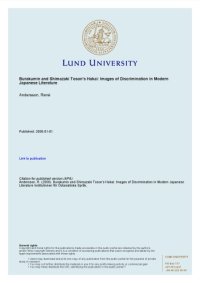
Ebook: Burakumin and Shimazaki Toson’s Hakai : images of discrimination in modern Japanese literature
Author: Andersson René
- Tags: Japan, Skønlitteratur-Japan, Litteraturhistorie, Diskrimination
- Year: 2000
- Publisher: Lund University
- City: Lund
- Language: English
- pdf
Published in 1906, Hakai or The Broken Commandment in English, by Shimazaki Tôson, is generally considered the first novel in the genre of shizenshugi, a Japanese variation of French Naturalisme. Traditionally, the novel has been viewed as an example of kokuhaku shôsetsu, or “confessional novel” in that the protagonist “confesses” his origin as a member of Eta¾an autochtonous and despised minority in Japan, in current days called Burakumin.Through the application of analytical tools in the field of Sociology of Literature, such as it has developed in the Nordic countries and particularly in Sweden, this thesis re-evaluates the content of Hakai and the intention of its author. This is achieved by a closer look at Shimazaki Tôson’s upbringing and activities at the time he wrote the novel while working as a schoolteacher in the small town of Komoro in Nagano. To understand the complex issue of discrimination in Japan at the early stage of its modernization period, a renewed analysis of the factors influencing the establishment of structural discrimination towards the group presently known as Burakumin is presented. Political factors during the last stages of the Tokugawa period (1600 – 1868) are of particular interest since these had a profound influence on the novel.The overriding hypothesis is that Tôson had socio-political motives when he wrote Hakai; to demonstrate this, the life of Ôe Isokichi is introduced. Ôe’s life functions as a role model for the novel and in particular for the actions and character of the protagonist. To understand the novel’s position within Japanese literature, works published prior to Hakai that concerned themselves with Burakumin and their status in Japan are also analyzed. Suiheisha¾an early organization struggling for Burakumin’s rights to be treated as equals¾criticized the novel as a blatant example of discrimination. This critique is scrutinized and an alternative reading to the Suiheisha interpretation is introduced and explained.
Download the book Burakumin and Shimazaki Toson’s Hakai : images of discrimination in modern Japanese literature for free or read online
Continue reading on any device:

Last viewed books
Related books
{related-news}
Comments (0)